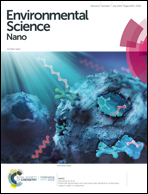In situ construction of layered graphene-based nanofiltration membranes with interlayer photocatalytic purification function and their application for water treatment†
Abstract
Layered graphene-based composite filtration membranes with interlayer photocatalysis activity have been successfully prepared by in situ photo-induced reduction of graphene oxide–TiO2 membranes. Owing to the mild reduction conditions as well as the unique properties of graphene-based sheets, the filtration performance of separation channels in membranes after in situ reduction is not only well preserved, but also additionally improved. Both the water flux and retention ratio of these graphene-based membranes are improved obviously compared with those of the original graphene oxide ones. Moreover, the plane separation channels in the membranes can also be endowed with additional photocatalytic function by the assembled TiO2 semiconductor supports between the surface membranes. Thus, when the filtration experiments are carried out under concurrent light irradiation, some pollutants penetrating into the channel due to the membrane's trade-off effect are further purified by photocatalysis, which further improves the performance in wastewater treatment of these graphene-based stacked filtration membranes.



 Please wait while we load your content...
Please wait while we load your content...